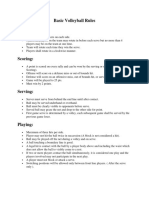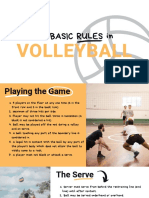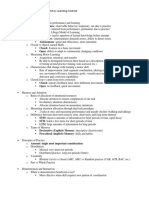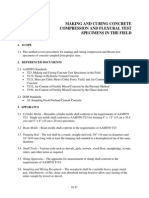100%(1)100% found this document useful (1 vote)
246 viewsVolleyball Rules and Regulations
Volleyball Rules and Regulations
Uploaded by
Jitend RanThe document outlines the basic rules and terminology of volleyball. It explains that the objective is to return the ball so it lands on the opponent's side of the net before they can return it. It details the rules of play, including serving, touching the ball, attacking, and rotating positions. It also defines the court dimensions and equipment such as the net height. Finally, it provides definitions for common volleyball terminology like blocking, passing, and substitutions.
Copyright:
© All Rights Reserved
Available Formats
Download as PDF, TXT or read online from Scribd
Volleyball Rules and Regulations
Volleyball Rules and Regulations
Uploaded by
Jitend Ran100%(1)100% found this document useful (1 vote)
246 views3 pagesThe document outlines the basic rules and terminology of volleyball. It explains that the objective is to return the ball so it lands on the opponent's side of the net before they can return it. It details the rules of play, including serving, touching the ball, attacking, and rotating positions. It also defines the court dimensions and equipment such as the net height. Finally, it provides definitions for common volleyball terminology like blocking, passing, and substitutions.
Original Description:
This the official FIBA rules book
Copyright
© © All Rights Reserved
Available Formats
PDF, TXT or read online from Scribd
Share this document
Did you find this document useful?
Is this content inappropriate?
The document outlines the basic rules and terminology of volleyball. It explains that the objective is to return the ball so it lands on the opponent's side of the net before they can return it. It details the rules of play, including serving, touching the ball, attacking, and rotating positions. It also defines the court dimensions and equipment such as the net height. Finally, it provides definitions for common volleyball terminology like blocking, passing, and substitutions.
Copyright:
© All Rights Reserved
Available Formats
Download as PDF, TXT or read online from Scribd
Download as pdf or txt
100%(1)100% found this document useful (1 vote)
246 views3 pagesVolleyball Rules and Regulations
Volleyball Rules and Regulations
Uploaded by
Jitend RanThe document outlines the basic rules and terminology of volleyball. It explains that the objective is to return the ball so it lands on the opponent's side of the net before they can return it. It details the rules of play, including serving, touching the ball, attacking, and rotating positions. It also defines the court dimensions and equipment such as the net height. Finally, it provides definitions for common volleyball terminology like blocking, passing, and substitutions.
Copyright:
© All Rights Reserved
Available Formats
Download as PDF, TXT or read online from Scribd
Download as pdf or txt
You are on page 1of 3
Name ______________________________________ Hour _______________
Vol l eybal l r ul es and r egul at i ons
The objective in volleyball is to keep the ball from striking the floor on your
side of the net and return it so that it strikes the floor on your opponents
side, before they can return it.
Play
The ball is put into play by the right back position (1) from behind
the rear boundary line using either an underhand or overhand serve.
The serve must go over the net within the court boundaries on the
other side. A serve that hits the net and still goes over to the other side
is a good serve and referred to as a let serve.
The ball can only be played with 3 touches, per team, per play, and
then must be sent over the net. The ball can go over the net with less
then 3 touches without penalty.
The ball may not be hit 2 times in a row by any one player.
Only front row players are allowed to contact the ball above the net
with intention to attack. However, a back row player may attack the
ball upon the net if they are behind the 10 ft. line.
If the serving team loses the serve (ball lands on their own side or ball
is hit out of bounds), the other team obtains service and a point. This
is called a side out/point.
A ball that lands on the boundary line is considered in.
For every side out made, the team that is awarded the serve must
rotate in a clockwise manner.
If the ball hits the ceiling and goes over the net, it is a dead ball. If the
ball hits the ceiling and falls back onto the original side, it is playable
if there are still hits available.
In rally scoring, a point is awarded at the end of every play no matter
who is serving.
Each game is played to 25 points and the winning team must win by at
least 2 points.
The match is a best of 5 contest.
Court and equipment
The court is 60 ft. long and 30 ft. wide
The boundary lines are 2 inches wide.
A 4 inch line divides the court at 30 ft.
A mens net is 8 ft. high
A womens net is 7 ft. 4 1/8 inches.
Court Positions:
Right back
Center back
Left back
Left front
Center front
Right front
Volleyball Terminology
1. Block: Defensive play by the player(s) in the front row who place
their hands and arms above the net so that a spiked ball rebounds into
the opponents court.
2. Pass: The forearm pass made on balls below the waist.
3. Game Point: The last point in any game.
4. Set: The overhead pass using the fingertips of an open hand
5. Rotation: The shifting of players, clockwise, just before a new person
serves.
6. Attack: An approach to the net, a vertical jump, and a forceful hit of
the ball down onto the opponents court.
7. Touch: When a player attempts to block the ball unsuccessfully and it
continues onto their own side of the court. This does not count as one
of the 3 hits allowed per side.
8. Tip: Attempting to trick the defense by dumping the ball right over
the net.
9. Defensive specialist (DS): A player who only plays in the back row.
10. Libero: A DS that wears a different color jersey from the rest of the
team that can enter the back row ONLY for any player throughout the
game. This does not count against the teams substitution count.
11. Substitution: At a dead ball opportunity, the coach signals the
referee that he/she would like to make a player change. In volleyball,
once a player subs in for another player, they cannot return in the
game for a different player. A total of 18 substitutions are allowed per
game.
You might also like
- Car Logos - Complete ListDocument7 pagesCar Logos - Complete ListOm75% (8)
- Daughter of Good Fortune: A Twentieth-Century Chinese Peasant MemoirDocument24 pagesDaughter of Good Fortune: A Twentieth-Century Chinese Peasant MemoirUniversity of Washington PressNo ratings yet
- ICSE Physical Education-VolleyballDocument24 pagesICSE Physical Education-VolleyballChirag90% (39)
- Moment of Inertia of Cracked SectionDocument33 pagesMoment of Inertia of Cracked SectionAtta Muhammad95% (20)
- Volleyballppt 170502065830Document14 pagesVolleyballppt 170502065830caranaybillycerdanNo ratings yet
- Volleyball: Objective of The GameDocument3 pagesVolleyball: Objective of The GameEden AniversarioNo ratings yet
- Volleyball 111111014852 Phpapp02Document23 pagesVolleyball 111111014852 Phpapp02Russian ThomasNo ratings yet
- Volleyball Basic RulesDocument2 pagesVolleyball Basic RulesangillyNo ratings yet
- Volleyball 4º ESODocument4 pagesVolleyball 4º ESOmenkaliwiam34No ratings yet
- PE 3313 - Team SportsDocument11 pagesPE 3313 - Team Sportsryu.azpiredNo ratings yet
- PE 3313 - Team SportsDocument15 pagesPE 3313 - Team Sportsryu.azpiredNo ratings yet
- Volleyball: Nature and PurposeDocument4 pagesVolleyball: Nature and PurposeFour EyesNo ratings yet
- Rules and Regulations of Volleybal, Fundamental Skill in Volleyball. Climacosa, John Louie M.Document5 pagesRules and Regulations of Volleybal, Fundamental Skill in Volleyball. Climacosa, John Louie M.george of tea timersNo ratings yet
- 4 Rules of games and Sports- VolleyballDocument17 pages4 Rules of games and Sports- Volleyballvimla tiwariNo ratings yet
- FINALSDocument15 pagesFINALSNicolleteNo ratings yet
- VOLLEYBALLDocument6 pagesVOLLEYBALLBluei Kallix AzulNo ratings yet
- Volleyball 101Document3 pagesVolleyball 101Samantha EstilongNo ratings yet
- Volleyball Terminology and Glossary PDFDocument2 pagesVolleyball Terminology and Glossary PDFChynde TemplaNo ratings yet
- Volleyball NotesDocument10 pagesVolleyball NotesmangoNo ratings yet
- Volleyball Study GuideDocument3 pagesVolleyball Study Guideapi-214829206No ratings yet
- Report PeDocument8 pagesReport PeRomel Lapinig DedanesNo ratings yet
- I. How Volleyball Is PlayedDocument14 pagesI. How Volleyball Is PlayedNicolleteNo ratings yet
- Volleyball BasicsDocument2 pagesVolleyball BasicsIsrael AlvarezNo ratings yet
- Football VocDocument9 pagesFootball VocFrancisco S. ArjonaNo ratings yet
- Volleyball Rules: Rule Violations That Result in A Point For The OpponentDocument8 pagesVolleyball Rules: Rule Violations That Result in A Point For The OpponentArvie MendozaNo ratings yet
- 4º ESO Volleyball TheoryDocument9 pages4º ESO Volleyball TheoryChiruNo ratings yet
- Volleyball Terminology and GlossaryDocument2 pagesVolleyball Terminology and GlossaryMegz OkadaNo ratings yet
- Basic Volleyball Rules: Rule Violations That Result in A Point For The OpponentDocument7 pagesBasic Volleyball Rules: Rule Violations That Result in A Point For The Opponentluiji yahabaNo ratings yet
- Basic Volleyball RulesDocument2 pagesBasic Volleyball Rulesmusadiqhyder11No ratings yet
- Hs Volleyball: SkillsDocument3 pagesHs Volleyball: Skillsanon-579447No ratings yet
- Volleyball Rules NotesDocument3 pagesVolleyball Rules NotesClarkson GodinezNo ratings yet
- Hockey NoteDocument8 pagesHockey NoteDan Marshall100% (1)
- Volleyball 1Document4 pagesVolleyball 1dikizatadiwaNo ratings yet
- Volleyball Study SheetDocument4 pagesVolleyball Study Sheetapi-291543693No ratings yet
- Compilation of Different Ball GamesDocument18 pagesCompilation of Different Ball Gamesrovick_delarosaNo ratings yet
- Volleyball Basic RulesDocument4 pagesVolleyball Basic RulesRengie GaloNo ratings yet
- VOLLEYDocument30 pagesVOLLEYAyra MaieNo ratings yet
- Basic Volleyball Rules and Terminology 2021Document8 pagesBasic Volleyball Rules and Terminology 2021Jowen Para CruzNo ratings yet
- Volleyball PDFDocument9 pagesVolleyball PDFJules Lyndon OrayeNo ratings yet
- Volleyball PDFDocument9 pagesVolleyball PDFJules Lyndon OrayeNo ratings yet
- Loofball PresentationDocument17 pagesLoofball PresentationLoofball SportNo ratings yet
- Peh 4Document7 pagesPeh 4JenNo ratings yet
- Q3-MAPEH6-LESSON3-VOLLEYBALLHISTORYDocument36 pagesQ3-MAPEH6-LESSON3-VOLLEYBALLHISTORYWandererNo ratings yet
- Volleyball Study GuideDocument2 pagesVolleyball Study GuideAnonymous MQjBLReGmXNo ratings yet
- Finals Pe4Document18 pagesFinals Pe4Merlyn NavarroNo ratings yet
- Rabadaa Cup Principles and RulesDocument6 pagesRabadaa Cup Principles and RulesStephen MusyokaNo ratings yet
- Hope2 q2 w3 4 LessonDocument6 pagesHope2 q2 w3 4 LessonLucky G. RupersoNo ratings yet
- Volleyball Study GuideDocument3 pagesVolleyball Study GuideLevirisa ManamtamNo ratings yet
- VOLLEYBALL2Document29 pagesVOLLEYBALL2Joyce MamokoNo ratings yet
- Volleyball Study GuideDocument2 pagesVolleyball Study Guideapi-233891658No ratings yet
- Examples of Term SheetsDocument4 pagesExamples of Term Sheetsapi-381353177No ratings yet
- VOLLEYBALLDocument3 pagesVOLLEYBALLHerlene CalilungNo ratings yet
- Volleyball HandoutDocument4 pagesVolleyball HandoutJihanesolaNo ratings yet
- U6-Rules-of-the-Game-OPSCDocument2 pagesU6-Rules-of-the-Game-OPSCtadilakshmikiranNo ratings yet
- Volleyball Teachers GuideDocument1 pageVolleyball Teachers Guideapi-19307690No ratings yet
- Newcombe Ball BookletDocument2 pagesNewcombe Ball Bookletla da100% (1)
- PEAHM 117 Team Sport (Basketball) : - Rules and Regulations - Responsibilities of Officials - Hand SignalsDocument7 pagesPEAHM 117 Team Sport (Basketball) : - Rules and Regulations - Responsibilities of Officials - Hand SignalsHanna Relator DolorNo ratings yet
- Volleyball and BasketballDocument10 pagesVolleyball and BasketballthevampsxNo ratings yet
- UntitledDocument5 pagesUntitledAthena LadipNo ratings yet
- Tugas Bahasa Inggris PenjasDocument7 pagesTugas Bahasa Inggris PenjasAmanda MutiaraNo ratings yet
- Football Physical TaskDocument7 pagesFootball Physical TaskSatwant SinghNo ratings yet
- Volleyball Study GuideDocument3 pagesVolleyball Study GuidecdvfrgvNo ratings yet
- Fundamentals of Flag & Tackle Football: For The Student AthleteFrom EverandFundamentals of Flag & Tackle Football: For The Student AthleteNo ratings yet
- Ennulle Nirainthaai - JsDocument97 pagesEnnulle Nirainthaai - JsJitend RanNo ratings yet
- Kallil Vaditha Kavithai - JsDocument154 pagesKallil Vaditha Kavithai - JsJitend RanNo ratings yet
- National Parks InfoDocument1 pageNational Parks InfoJitend RanNo ratings yet
- Sahodaya Event Calendar14-15Document13 pagesSahodaya Event Calendar14-15Jitend RanNo ratings yet
- Throw Ball RulesDocument1 pageThrow Ball RulesJitend RanNo ratings yet
- ZZZZZZZZZZZZZZDocument2 pagesZZZZZZZZZZZZZZabdul qayyumNo ratings yet
- LG Lighting Catalogue - 2012Document43 pagesLG Lighting Catalogue - 2012Muhidin KozicaNo ratings yet
- f3825 Lte&Wcdma Router SpecificationDocument3 pagesf3825 Lte&Wcdma Router SpecificationCocofourfaithNo ratings yet
- Astm A1095 15 2023Document3 pagesAstm A1095 15 2023Fernando MartinezNo ratings yet
- Reading Ex 1Document5 pagesReading Ex 1thaodtpengNo ratings yet
- FORMAT Prelims 7Ps AND 4Ms FADocument34 pagesFORMAT Prelims 7Ps AND 4Ms FASelle FlorendoNo ratings yet
- Ceiling MineralFiberCeilingDocument10 pagesCeiling MineralFiberCeilingBeatrizLlamasNo ratings yet
- Chronic Myeloid Leukemia (CML) 3Document1 pageChronic Myeloid Leukemia (CML) 3Augustine A. KollieNo ratings yet
- Internship CV TemplateDocument2 pagesInternship CV Templatedazdaook daodaNo ratings yet
- Cbjescpu 25Document11 pagesCbjescpu 25bprkupraveenNo ratings yet
- 1ac Hebron UilDocument17 pages1ac Hebron Uillinuspauling101No ratings yet
- Motor Learning ReviewDocument2 pagesMotor Learning Reviewbob poopersteinNo ratings yet
- 2020 10 VN No KeyDocument50 pages2020 10 VN No KeyGia Đình SâuNo ratings yet
- Primary Three Exam Question.Document17 pagesPrimary Three Exam Question.ogidan preciousNo ratings yet
- Practica de Ingles1Document7 pagesPractica de Ingles1jhon cristian valenciaNo ratings yet
- Ece-V-Digital Signal Processing U1 PDFDocument16 pagesEce-V-Digital Signal Processing U1 PDFlathavenkyNo ratings yet
- DLL Matatag - English 7 q2 w4Document19 pagesDLL Matatag - English 7 q2 w4sombriokathleenjayNo ratings yet
- MGT320 Ch01Document24 pagesMGT320 Ch01Payman RowhaniNo ratings yet
- F7 (FR) Revision KitDocument6 pagesF7 (FR) Revision KitAye Myat ThawtarNo ratings yet
- Acc Unit-9-AnswersDocument11 pagesAcc Unit-9-AnswersGeorgeNo ratings yet
- Manufacturing Project RibDocument6 pagesManufacturing Project RibRahul KaruvingalNo ratings yet
- Use of English File: Unit 5: On A Business TripDocument20 pagesUse of English File: Unit 5: On A Business TripOsmarNo ratings yet
- Personal Financial Planning LectureDocument52 pagesPersonal Financial Planning LectureSara LlameraNo ratings yet
- Making and Curing Concrete BeamsDocument5 pagesMaking and Curing Concrete BeamsjjaavenidoNo ratings yet
- Paper 2Document15 pagesPaper 2lutfi istiqomah100% (1)
- Warehousing Unit - 3Document55 pagesWarehousing Unit - 3pramav2411No ratings yet
- tECHNO GEDocument14 pagestECHNO GESrinjoy SarkarNo ratings yet
- CH 15Document59 pagesCH 15nish.wanjariNo ratings yet































































































